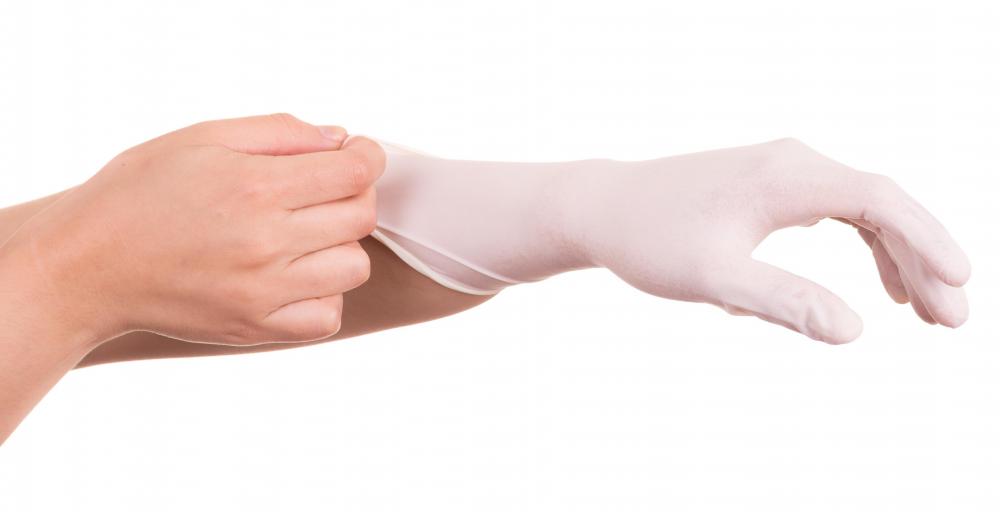At HomeQuestionsAnswered, we're committed to delivering accurate, trustworthy information. Our expert-authored content is rigorously fact-checked and sourced from credible authorities. Discover how we uphold the highest standards in providing you with reliable knowledge.
How do I Remove Mold on Sheetrock?
Removing mold on sheetrock that has been previously primed or painted is a relatively simple procedure. Before you begin, locate the source of the moisture causing the mold and remove it to prevent future mold growth. To remove the existing mold on sheetrock, you will need to mix a solution of one part chlorine bleach to four parts of water. After donning protective gear as necessary, apply the solution to the sheetrock using a sponge or spray bottle. After the mold has been removed, rinse and dry the surface well and apply a stain blocking primer or sealer before repainting the surface.
Before removing mold on sheetrock, you should inspect the surrounding area to determine the cause of the mold. Any leaks in the roof or plumbing should be repaired to prevent the mold from reoccurring. If the mold is being caused by condensation, you may need to install a dehumidifier in the room. If the sheetrock has been saturated or damaged by water, it will probably need to be replaced. Extremely large areas of mold on sheetrock may need to be disposed of by a professional to prevent the spores from spreading onto carpets, draperies, furniture, or ductwork.

It is important to protect yourself from the disturbed mold spores by wearing a respirator during the mold removal procedure. You will also need to wear latex or vinyl gloves to protect your skin from the chlorine cleaning solution. Proper ventilation is essential during this procedure; open as many doors and windows as possible before beginning the work. If you are working on an overhead area, you will also need protective eye wear. Cover the floor and surrounding areas with plastic sheeting to avoid staining the carpeting, flooring, or furniture.

Next, make a chlorine cleaning solution of one part household bleach to four parts water. You may mix this solution in a plastic bucket or spray bottle. Apply the solution to the sheetrock, wait 15 minutes, and scrub thoroughly with a sponge, soft brush, or cleaning cloth. Repeat this process using a fresh chlorine solution and scrubber until the mold is completely removed. Use as little of the chlorine solution as possible to avoid saturating the sheetrock surface.

After you have successfully removed the mold, rinse the sheetrock surface thoroughly to remove any chlorine residue and use a mild cleanser to prepare the surface for priming and painting. Dry the sheetrock completely using a towel or blow dryer. Dispose of all plastic sheeting, cleaning cloths, brushes, and sponges used during the mold removal procedure to prevent regrowth. If the area is still damp from a previous water leak, it is a good idea to place a dehumidifier in the room for several days prior to painting. Finally, apply a stain-blocking primer or sealer to the sheetrock before repainting it.
AS FEATURED ON:
AS FEATURED ON:













Discussion Comments
Anytime you have water damage you should take precautions to prevent mold from growing. The chlorine bleach solution mentioned in this article is a good way to stop the mold before it has a chance to take hold and cause you a lot of problems with your health. And the cost of removing mold in homes can be very expensive once the growth spreads.
I have a friend who began having a lot of health problems and she couldn't figure out what was going on. One thing see noticed early on was that her eyes bothered her. She would have really red eyes sometimes, and she couldn't figure out why, and then her vision became less and less clear. She thought maybe this was just because she was getting older and maybe she was also straining her eyes in some way.
Well, she went through a long list of symptoms, including coughing and wheezing and other breathing problems before she went to the doctor and the doctors figured out that she was having some serious health issues. Eventually, they figured out she was suffering from black mold symptoms.
When inspectors went to her house, they found black mold behind one of the walls and in the crawl space and in or near the vents. There is no way of knowing exactly how long she had been breathing in the mold.
I renovate old houses and one of the biggest repairs I run into in the bathrooms is the removal of mold. These old houses were not built with bathroom exhaust fans installed originally, so they have experienced years of high levels of humidity and moisture. I use a humidifier like the article suggests to remove the moisture during renovation, but this is simply a temporary solution until I can get bathroom fans installed.
The bathroom fans make a world of difference. You might be surprised at how much moisture goes into the air when you shower and how much of that moisture a good exhaust fan can remove. A fan will eliminate the growth of a good deal of bathroom mold.
Post your comments